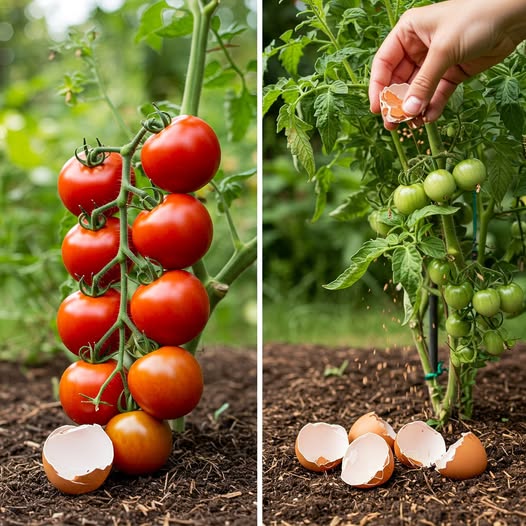Never throw away eggshells, but use them in this way
Understanding the Problem: The Role of High Temperatures
One of the primary reasons for fruit rot is extreme heat. When temperatures exceed 30°C (86°F), plants struggle to circulate nutrients efficiently. This disruption in nutrient absorption marks the beginning of various problems, including blossom-end rot in tomatoes and peppers.
Most of us have learned that a lack of calcium is the main culprit behind this issue, but understanding how to address the deficiency is just as important. Plants require calcium from the flowering stage through fruit development, meaning it should be supplied early—right when flowers begin to appear. Ideally, the soil should already contain a sufficient amount of calcium and other essential nutrients, but achieving this balance can be difficult, especially if we grow plants in the same location year after year.
Restoring Calcium to the Soil
To maintain nutrient-rich soil, we must replenish it regularly. A simple and effective way to do this is through composting. At our garden, we maintain a compost bin where we dispose of biodegradable waste from both the kitchen and the garden. Over time, this waste decomposes and transforms into nutrient-rich compost, which we then incorporate into the soil when planting new crops.
Every gardener should consider composting, as it not only enriches the soil but also promotes eco-friendly waste disposal. However, compost has a tendency to dry out, which can slow the decomposition process. To prevent this, we recommend constructing a simple compost bin using wooden boards. This setup helps retain moisture, making composting more efficient.
The Importance of Earthworms and Microorganisms
Moisture is crucial in composting, as it supports the organisms responsible for decomposition. Earthworms, in particular, play a significant role in breaking down organic matter and improving soil fertility. Additionally, microorganisms contribute to the breakdown of waste materials, ensuring that essential nutrients are available for plant growth. A garden rich in earthworms is a sign of healthy, fertile soil.
To further enhance the compost, we regularly add water and mix in biodegradable waste. We also incorporate manure, which is packed with macro-elements essential for plant development. Additionally, we introduce organic materials rich in micro-elements like magnesium, boron, copper, and iron.
Utilizing Eggshells for Calcium Enrichment
One commonly available source of calcium is eggshells. Since eggs are frequently used in cooking, their shells should never be discarded as waste. Instead, they can be collected and added to compost.
To accelerate decomposition, eggshells can be crushed into small pieces using a blender or another tool before being mixed into the compost pile. While calcium from eggshells is not immediately available to plants, it gradually breaks down over time, enriching the soil year after year. Consistently applying eggshells to compost will yield positive results in the long run.
After thoroughly mixing the compost, we allow it to sit until autumn, when we begin planting. Regular watering and mixing are essential to maintain an active decomposition process. To prevent the compost from drying out, we cover it with a layer of straw mulch.
Addressing Nutrient Absorption Challenges
Even when soil is rich in nutrients, plants may struggle to absorb them during extreme heat. This is because the process of nutrient uptake slows down in high temperatures. In such cases, foliar feeding—applying nutrients directly to the leaves—can be an effective solution.
If you notice signs of rot on your tomatoes and peppers, remove and discard the affected fruits immediately. Then, apply calcium directly to the plants through foliar spraying. Calcium-based liquid nutrients are widely available and easy to use. One effective option is VitalPower Calcio, a preparation that contains not only calcium but also other essential nutrients for plant health.
How to Apply Foliar Nutrients
Foliar feeding is most effective when done in the late evening, as this allows plants to absorb the nutrients overnight without the risk of evaporation due to sunlight. Liquid calcium solutions can be diluted in water and sprayed evenly over the leaves.
Alternatively, calcium-enriched fertilizers can be added to irrigation water, allowing plants to absorb the nutrient through their root systems. If fruit rot is already present, foliar feeding provides the quickest results, helping plants recover faster.
For best results, use a concentration of 30 ml of calcium solution per 10 liters of water, whether applied via watering or foliar spraying.
Share Your Gardening Experience
We have shared many tips on fruit and vegetable nutrition in our previous videos, so be sure to check them out for additional guidance. We’d love to hear from you! Share your experiences in the comments:
- How do you fertilize your plants?
- How has the summer heat affected your crops this year?
- What methods have you used to improve plant growth and prevent nutrient deficiencies?
Lastly, since the weather is scorching, we could all use a refreshing treat. Send us your favorite cooling recipes, and we might feature one in an upcoming video for all of us to enjoy!
Thank you for being a part of our community. Happy gardening!
